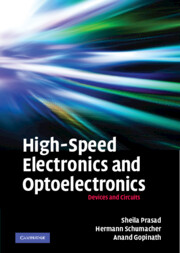5 - Building blocks for high-speed analogue circuits
from Part Two - Circuits
Published online by Cambridge University Press: 05 August 2012
Summary
Executive summary
This chapter is about the use of electronic devices in elementary circuit blocks found in any micro- or millimetre-wave system – or in the analogue portions of fibre-optic communications systems. An introductory section describes linear two-ports on the basis of scattering parameters, discusses different gain definitions and treats important aspects of stability as well as noise in two-ports, with special emphasis on noise reduction by proper choice of generator impedance.
Following this, amplifiers, oscillators and mixers are described in sequence. In the amplifier section, small-signal parameters are used to derive fundamental properties of common topologies, from the simplest, one-transistor circuits to more complex gain cells, such as the cascode and differential amplifiers. Tuned amplifiers are covered, as well as broadband amplifier techniques, including distributed amplification. Finally, low-noise and power amplifiers are being treated, as well as non-linearities in amplifiers.
The oscillator section discusses how small-signal instability and non-linear gain compression effects combine to create stable sinusoidal oscillations. Important oscillator topologies and noise phenomena affecting the phase stability of oscillators are also covered.
Mixer circuits show how specifically designed non-linear circuits provide frequency translating capabilities. Mixing principles are discussed first, followed by several mixer topologies using field effect and bipolar transistors.
Basic relations for two-port networks
Scattering parameter theory
Small signal equivalent circuits for semiconductor devices and circuits are usually represented in two-port form as shown in Figure 5.2. At low frequencies, two-port networks are represented by an impedance matrix, an admittance matrix, a hybrid matrix or a chain matrix.
Information
- Type
- Chapter
- Information
- High-Speed Electronics and OptoelectronicsDevices and Circuits, pp. 291 - 422Publisher: Cambridge University PressPrint publication year: 2009
